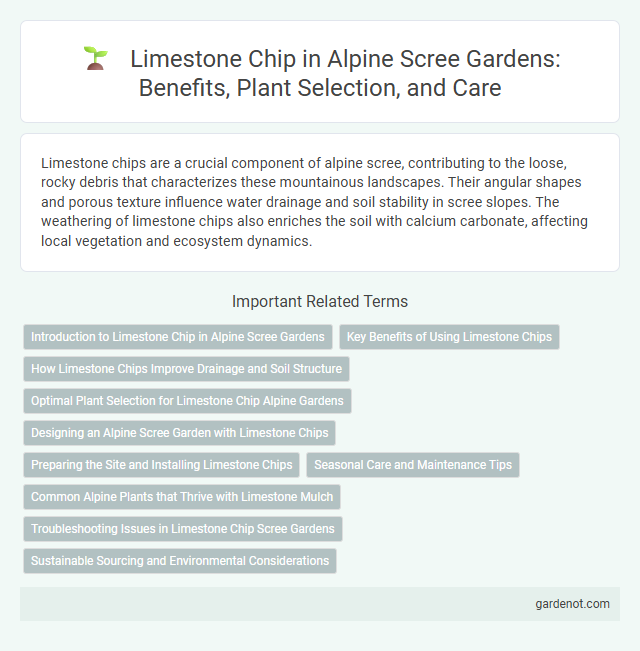Limestone chips are a crucial component of alpine scree, contributing to the loose, rocky debris that characterizes these mountainous landscapes. Their angular shapes and porous texture influence water drainage and soil stability in scree slopes. The weathering of limestone chips also enriches the soil with calcium carbonate, affecting local vegetation and ecosystem dynamics.
Introduction to Limestone Chip in Alpine Scree Gardens
Limestone chip is a popular choice in alpine scree gardens due to its excellent drainage properties and alkaline pH, which favors many alpine plants adapted to calcareous soils. This natural stone enhances soil aeration and prevents waterlogging, crucial for the survival of delicate alpine species such as saxifrage and alpine asters. Incorporating limestone chip into scree gardens supports healthy root development and mimics the native rocky habitats found in mountainous regions.
Key Benefits of Using Limestone Chips
Limestone chips offer excellent drainage properties, making them ideal for alpine scree environments that require effective water runoff management. Their natural alkalinity helps neutralize acidic soils, promoting healthier plant growth in harsh mountain terrains. Durable and resistant to weathering, limestone chips provide long-lasting ground cover that stabilizes loose scree slopes and reduces erosion.
How Limestone Chips Improve Drainage and Soil Structure
Limestone chips enhance drainage by creating larger pore spaces within alpine scree soils, allowing water to flow more freely and reducing waterlogging risks. Their alkaline properties help neutralize soil acidity, improving nutrient availability and promoting beneficial microbial activity. Incorporating limestone chips also enhances soil structure by increasing aggregation, which supports root development and stabilizes the scree environment.
Optimal Plant Selection for Limestone Chip Alpine Gardens
Limestone chip in Alpine scree gardens provides excellent drainage and alkaline pH, ideal for calcicolous alpine plants such as Dianthus, Primula, and Saxifraga species. Selecting drought-tolerant, low-nutrient-demand plants ensures robust growth and mimics native habitats. Optimal plant selection enhances ecological balance and aesthetic appeal in limestone chip Alpine gardens.
Designing an Alpine Scree Garden with Limestone Chips
Limestone chips provide excellent drainage and a natural, light-colored aesthetic essential for Alpine scree gardens, replicating their native rocky habitats. Their alkaline pH supports calcicole plants such as saxifrage, edelweiss, and dwarf conifers that thrive in well-drained, mineral-rich soils. Incorporating varying chip sizes enhances texture and stability while minimizing moisture retention to prevent root rot in sensitive Alpine species.
Preparing the Site and Installing Limestone Chips
Preparing the site for installing limestone chips on Alpine scree involves thorough clearing of loose debris and leveling the terrain to ensure proper drainage and stability. The limestone chips should be evenly spread in a layer 5 to 10 centimeters thick, allowing natural settling and minimizing erosion. Proper installation supports vegetation growth by improving soil aeration and conserving moisture in fragile mountainous ecosystems.
Seasonal Care and Maintenance Tips
Limestone chip used in alpine scree landscaping requires seasonal care to prevent erosion and maintain its natural appearance, especially during heavy rainfall in spring and autumn. Regular raking helps redistribute displaced stones and removes debris that can harbor moisture and lead to moss growth. Inspecting the scree after winter freeze-thaw cycles ensures stability and reduces the risk of soil displacement or plant root damage.
Common Alpine Plants that Thrive with Limestone Mulch
Limestone chip mulch creates an alkaline environment ideal for common Alpine plants such as Saxifraga, Dryas octopetala, and Armeria maritima, which thrive in well-drained, calcareous soils. These plants benefit from the chip's ability to regulate moisture while providing essential minerals that enhance root development and foliage health. The high calcium carbonate content in limestone chips supports the growth of calciphile species, promoting biodiversity in scree gardens.
Troubleshooting Issues in Limestone Chip Scree Gardens
Limestone chip in Alpine scree gardens often faces issues such as pH imbalance, which can affect plant health and nutrient availability. Problems like poor drainage or compaction of the limestone chips can lead to root rot and hinder proper aeration for scree-adapted plants. Regular monitoring and adjustment of soil conditions, along with proper chip size selection, are essential to maintain optimal growth and prevent common troubles in these gardens.
Sustainable Sourcing and Environmental Considerations
Limestone chip used in alpine scree is sustainably sourced from quarries practicing responsible extraction to minimize ecosystem disruption and preserve natural habitats. Environmental considerations include low-impact transportation methods and strict adherence to regulations that protect water quality and reduce carbon emissions. The emphasis on using recycled materials and efficient resource management supports long-term ecological balance in sensitive alpine regions.
Limestone chip Infographic

 gardenot.com
gardenot.com